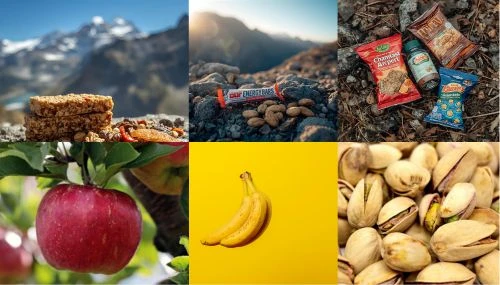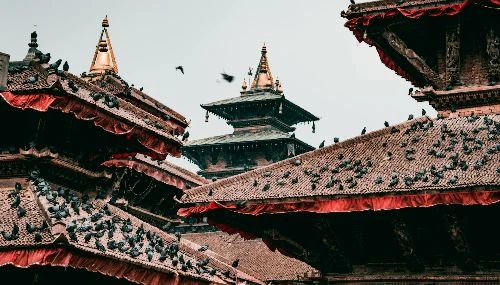A bustling market town called Namche Bazaar lies in Nepal's Khumbu area. At 3,440 meters (11,286 feet) above sea level, it is the entrance to the famed Mount Everest region and a destination preferred as an acclimatization location for hikers and climbers. Namche Bazaar is renowned for its amazing natural beauty, vibrant Sherpa culture, and breathtaking vistas of the neighboring Himalayan ranges.
The local Sherpa community gathers in Namche Bazaar, which has several hotels, lodges, restaurants, and shops that sell anything from traditional handicrafts to mountaineering equipment. Yaks and donkeys are used to move supplies through the congested streets, while houses are decorated with vibrant prayer flags.
There are several reasons to visit Namche Bazaar. It is a major resting spot for trekkers and climbers traveling to Everest Base Camp and other high-altitude locations in the Khumbu region. There are numerous options for hiking and exploring the surrounding region in the town. Namche Bazaar is a great location for those interested in Sherpa culture to learn about the locals' traditional way of life and to visit old monasteries and museums.
Visitors to Namche Bazaar may anticipate a distinctive fusion of traditional Sherpa culture and contemporary conveniences. During the busiest time of the day, the town is a hive of activity and home to wonderful conversations, delightful mountain views, and a secluded lifestyle that will make you thirst for this place in the days to come as well.
Location
Namche Bazaar lies in Nepal's Solukhumbu District. It is located in the Khumbu region of the Himalayas at a height of 3,440 meters (11,286 ft) above sea level. On their journey to Mount Everest and other high peaks in the area, trekkers and mountaineers frequently stop in Namche Bazaar.
A subarctic environment, with freezing temperatures and dry conditions for the majority of the year, is present at Namche Bazaar. In the summer (June to August), the day average temperature ranges from 10 to 20 degrees Celsius (50 to 68 degrees Fahrenheit), while the overnight low is below zero. Temperatures throughout the winter (December to February) can drop as low as -15 degrees Celsius.
Due to its high altitude, Namche Bazaar's temperature drops significantly at night. Wintertime snowfall in the town can range from light to heavy, which can make hiking in the area difficult.
Namche Bazaar is situated in a valley surrounded by snow-covered mountains, including the well-known Mount Everest. For individuals unfamiliar with high altitude conditions, trekking to and from Namche Bazaar might be difficult due to the town's location on a steep slope.
History
Namche Bazaar was first established in the 16th century as a tiny community of traders and yak herders. Indigenous to the region, the Sherpas formed their culture and customs in Namche Bazaar after arriving there in the 18th century. In and around the town, they constructed homes, monasteries, and chortens (Buddhist shrines).
The Sherpas are well known for their expertise in mountaineering and have a close bond with the Himalayas. They think that the mountains are sacred and home to the gods. Yak herding, trading, and mountain climbing comprised the Sherpas' traditional way of life. As the hub of trade and commerce in the area, Namche Bazaar was essential to all of these activities.
The architecture and religious buildings of Namche Bazaar are a reflection of its significance in Sherpa culture. Many monasteries, chortens, and prayer flags can be seen throughout the town and are used for ceremonial religious and cultural events. Namche Bazaar is a well-known tourist destination as a result of the distinctive culture and customs of the Sherpas, which have drawn visitors and mountaineers from all over the world.
When it became a center for the trade of salt, wool, and barley between Tibet and Nepal in the 19th century, Namche Bazaar started to develop into a major commerce hub. The town served as a crucial stopover for traders going between the two countries because of its placement on the commerce route. The trade at Namche Bazaar changed in the early 20th century to include exchanging items with the British who were constructing roads and railroads.
Attractions
Natural Attractions
The amazing views of Mount Everest and other peaks are a highlight for any tourist to Namche Bazaar, while Sagarmatha National Park shows the splendor of the Himalayan region and offers the chance to spot uncommon wildlife.
Cultural Attractions
While the Sherpa Museum offers insight into the history and customs of the area, Namche Bazaar's monasteries offer a chance to learn about and engage with the spiritual and cultural activities of the Sherpa community.
Outdoor Activities
Trekking to high-altitude locations gives a distinctive and challenging trip that is guaranteed to be enjoyable while hiking in the gorgeous surroundings of Namche Bazaar offers a chance to admire the natural beauty of the area and explore nearby villages and sites.
Food In Namche Bazaar
To satisfy the varied tastes of tourists and hikers, Namche Bazaar's cuisine offers a distinctive fusion of traditional Sherpa cuisine and international specialties. The numerous aspects of food in Namche Bazaar are broken down as follows:
The traditional food of the Sherpas is unique and greatly influenced by the Himalayan terrain. Boiling potatoes, butter tea, and tsampa (roasted barley flour) make up the traditional Sherpa supper (made with yak milk). Thukpa, a noodle soup with either meat or veggies, is another well-liked Sherpa meal. Momos (steamed dumplings), Sherpa stew (meat, potatoes, and veggies), and yak meat dishes are more examples of traditional Sherpa cuisine. Sherpa food is renowned for its flavorful simplicity and utilization of regional ingredients.
Popular foods:
Namche Bazaar offers popular dishes from all over the world in addition to traditional Sherpa cuisine. Pizza, hamburgers, pasta, and other cuisines are all common foods. Pancakes, omelets, and porridge are among the breakfast options.
Best Places to Eat
The best restaurants may be found in Namche Bazaar, which includes a variety of eateries. The following are some of Namche Bazaar's top restaurants:
Namaste Cafe: This well-known eatery offers a wide selection of foods, including Western and Nepalese fare. The cafe is a terrific spot to hang out with friends because of its laid-back vibe.
Café Danphe Bar is a little eatery that offers Sherpa and foreign food. After a day of hiking, you can relax in the restaurant's cozy and welcoming ambiance.
Himalayan Cafe: This eatery offers a rooftop terrace with breathtaking views of the Mountains and serves both Nepali and foreign food. The cafe is renowned for its top-notch fare and assistance.
Shopping
Visitors to the area should shop in Namche Bazar, where they may get one-of-a-kind souvenirs and locally produced goods.
The town is well-known for its extensive range of souvenirs, which include traditional Tibetan prayer flags, vibrant woolen hats and scarves, complex handcrafted jewelry, and a variety of handicrafts produced from yak wool and other materials. These goods are well-liked by both tourists and residents and make wonderful souvenirs of a trip to the area.
Local goods: Namche Bazaar is where you may get a wide range of regional goods, including handcrafted pottery, carpets, and textiles that are created using conventional techniques and frequently have elaborate designs and vibrant colors. There are also locally produced foods available, such as yak cheese and honey.
The best places to shop: Namche Bazaar is home to a variety of stores and markets that sell souvenirs and regional goods. The Saturday market is a particularly well-liked hangout since it has a lively ambiance and a large selection of goods for sale. The Khumbu Art Gallery and Namche Bazaar Handicraft Center, both of which feature regional artwork and crafts, are additional well-liked shopping destinations. When shopping in the area, visitors are encouraged to expect to haggle since this is a frequent habit.
Getting There
It might be difficult but worthwhile to go to Namche Bazaar, the entrance to Mount Everest. Here are some options for getting to Namche Bazaar:
Flights to Lukla:
Taking a flight from Kathmandu to Lukla is the easiest method to get to Namche Bazaar. The trip to Lukla, a small village near Mount Everest, takes around 30 minutes. The flight, which is regarded as one of the world's most picturesque, provides breathtaking vistas of the Himalayas. Trekkers can hike from Lukla to Namche Bazaar for two days.
Hiking paths
There are several routes you might take to reach Namche Bazar. The Everest Base Camp Trek, the Tibetan Plateau Trek, the Gokyo Lakes Trek, and the Three Passes Trek. These treks vary in difficulty and duration, but all offer stunning views of the Himalayas and a chance to experience the local culture.
Tips for Planning
The following advice is crucial to take into account when organizing a trip to Namche Bazaar:
The best times to visit Namche Bazaar are in the spring (March–May) and fall (September–November) seasons, when the weather is clear and the skies are blue.
Get the required licenses: To visit the Everest region, trekkers must have a TIMS (Trekkers' Information Management System) Card and a Sagarmatha National Park Permit.
Employ a guide or porter: Hiring a guide or porter is advantageous, particularly for novice trekkers. They can help with trail navigation and transporting luggage.
Bring the right things: Making sure you have the right clothing and equipment for the hike is crucial.
Safety
To guarantee a safe and pleasurable journey to Namche Bazaar, it is necessary to take a few safety measures. Regarding safety in Namche Bazaar, keep the following points in mind:
Acute mountain sickness (AMS), often known as altitude sickness, is a common issue for trekkers in the Everest region. While Namche Bazaar is located at 3,440 meters above sea level, some people may experience altitude sickness. From moderate to severe, AMS symptoms can include headache, lightheadedness, exhaustion, and nausea.
Hiking safety: Trekking in the Everest region can be difficult and calls for the right equipment, knowledge of the terrain, and physical fitness. Hiring a knowledgeable guide or porter to help with navigating and luggage carrying is advised. Moreover, hikers should avoid hiking alone and let someone know where they are going and when they anticipate arriving.
To prevent being lost or hurt, it is crucial to listen to the guide's directions and stay on the approved trail. Trekkers should also carry the necessary equipment, such as warm clothing, rain gear, and a first aid kit, and be ready for sudden changes in the weather.
Additional precautions: While in Namche Bazaar, additional safety measures should be taken in addition to those for altitude sickness and trekking. To prevent getting sick from drinking unclean water, it is advised to drink bottled or heated water. To stop the spread of infections, it's crucial to practice excellent hygiene, which includes washing your hands. Trekkers should also be mindful of regional traditions and show respect for the Sherpa culture, which is prevalent in the area.
Conclusion
Namche Bazaar is a delight of a place. Its wonderful vistas, unique way of life, and towering hills make it a gorgeous place that should be on your bucket list of places to go. But before you plan to come, make sure you follow our advice and make all the necessary arrangements. If you want to get there, don’t forget to write to us. We can make the best arrangements for you to get there.


.webp)

